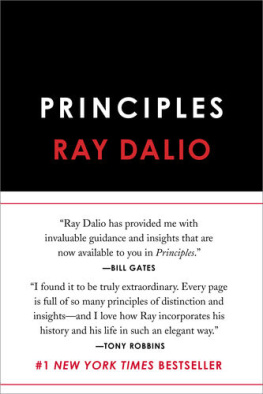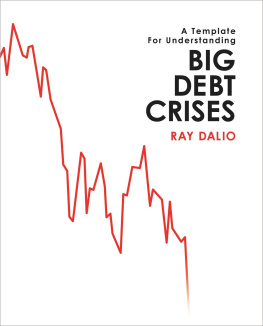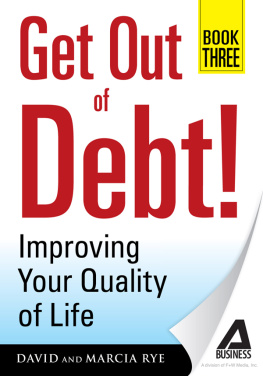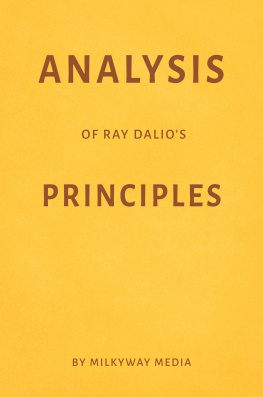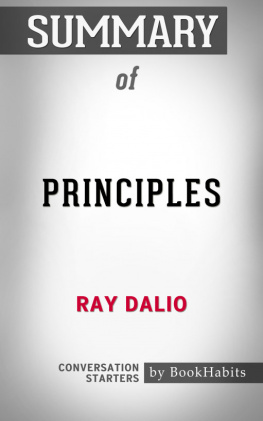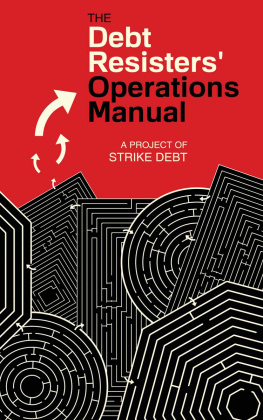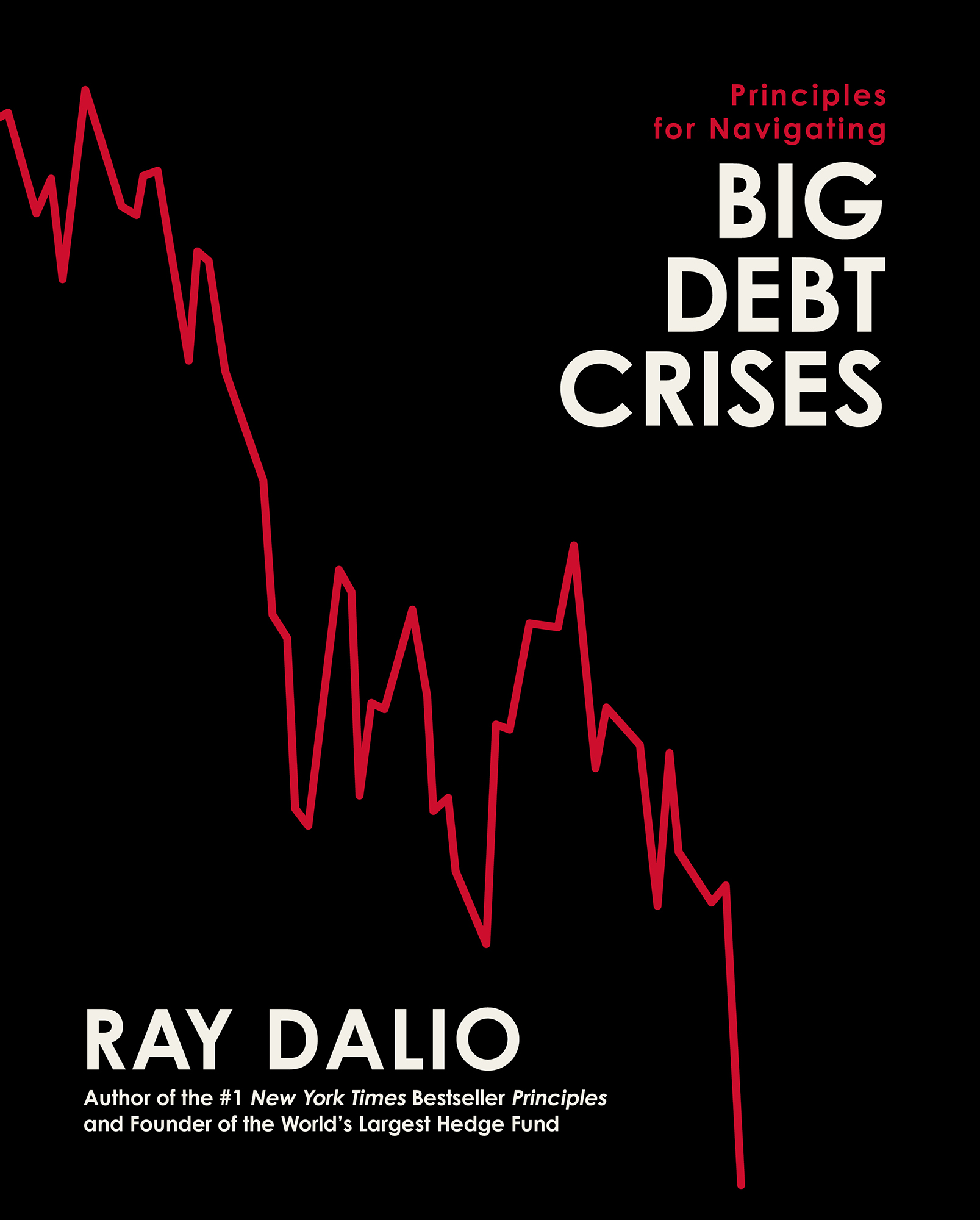Contents
Guide
Principles for Navigating Big Debt Crises
Ray Dalio
Author of the #1 New York Times Bestseller Principles and Founder of the Worlds Largest Hedge Fund
Acknowledgments
I cannot adequately thank the many people at Bridgewater who have shared, and continue to share, my mission to understand the markets and to test that understanding in the real world. I celebrate the meaningful work and meaningful relationships that we have had and that have led to the understandings and principles that have enriched us in the most profound ways.
The list of great partners includes Bob Prince, Greg Jensen and Dan Bernstein, who have worked with me over decades, my current investment research team (especially Steven Kryger, Gardner Davis, Bill Longfield, Anser Kazi, Danny Newman, Michael Savarese, and Elena Gonzalez Malloy), members of my past research teams (especially Brian Gold, Claude Amadeo, Bob Elliott, Mark Dinner, Brandon Rowley, and Jason Rogers), and many others who have worked with me on research over the years. Im also indebted to the many other leaders in Bridgewater research, including Jason Rotenberg, Noah Yechiely, Larry Cofsky, Ramsen Betfarhad, Karen Karniol-Tambour, Kevin Brennan, Kerry Reilly, Jacob Kline, Avraam Sidiropoulos, Amit Srivastava, and our treasured former colleague Bruce Steinberg, whom we tragically lost last year.
PART 1: THE ARCHETYPAL BIG DEBT CYCLE
PART 1: THE ARCHETYPAL BIG DEBT CYCLE
Introduction
I am writing this on the tenth anniversary of the 2008 financial crisis in order to offer the perspective of an investor who navigated that crisis well because I had developed a template for understanding how all debt crises work. I am sharing that template here in the hope of reducing the likelihood of future debt crises and helping them be better managed.
As an investor, my perspective is different from that of most economists and policy makers because I bet on economic changes via the markets that reflect them, which forces me to focus on the relative values and flows that drive the movements of capital. Those, in turn, drive these cycles. In the process of trying to navigate them, Ive found there is nothing like the pain of being wrong or the pleasure of being right as a global macro investor to provide the practical lessons about economics that are unavailable in textbooks.
After repeatedly being bit by events I never encountered before, I was driven to go beyond my own personal experiences to examine all the big economic and market movements in history, and to do that in a way that would make them virtual experiencesi.e., so that they would show up to me as though I was experiencing them in real time. That way I would have to place my market bets as if I only knew what happened up until that moment. I did that by studying historical cases chronologically and in great detail, experiencing them day by day and month by month. This gave me a much broader and deeper perspective than if I had limited my perspective to my own direct experiences. Through my own experience, I went through the erosion and eventual breakdown of the global monetary system (Bretton Woods) in 19661971, the inflation bubble of the 1970s and its bursting in 197882, the Latin American inflationary depression of the 1980s, the Japanese bubble of the late 1980s and its bursting in 19881991, the global debt bubbles that led to the tech bubble bursting in 2000, and the Great Deleveraging of 2008. And through studying history, I experienced the collapse of the Roman Empire in the fifth century, the United States debt restructuring in 1789, Germanys Weimar Republic in the 1920s, the global Great Depression and war that engulfed many countries in the 193045 period, and many other crises.
My curiosity and need to know how these things work in order to survive them in the future drove me to try to understand the cause-effect relationships behind them. I found that by examining many cases of each type of economic phenomenon (e.g., business cycles, deleveragings) and plotting the averages of each, I could better visualize and examine the cause-effect relationships of each type. That led me to create templates or archetypal models of each typee.g., the archetypal business cycle, the archetypal big debt cycle, the archetypal deflationary deleveraging, the archetypal inflationary deleveraging, etc. Then, by noting the differences of each case within a type (e.g., each business cycle in relation to the archetypal business cycle), I could see what caused the differences. By stitching these templates together, I gained a simplified yet deep understanding of all these cases and could develop principles for navigating them well. Rather than seeing lots of individual things happening, I saw fewer things happening over and over again, like an experienced doctor who sees each case of a certain type of disease unfolding as another one of those.
I did the research and developed this template with the help of many great partners at Bridgewater Associates. This template allowed us to prepare better for storms that had never happened to us before, just as one who studies 100-year floods or plagues can more easily see them coming and be better prepared. We used our understanding to develop our principles and build computer decision-making systems that laid out in detail exactly how wed react to virtually every possible occurrence. This approach helped us enormously. For example, eight years before the financial crisis of 2008, we built a depression gauge that was programmed to respond to the developments of 20072008, which had not occurred since 192932. This allowed us to do very well when most everyone else did badly.
While I wont get into Bridgewaters detailed decision making systems, in this study I will share the following: 1) my template for the Archetypal Big Debt Cycle, 2) Three Iconic Case Studies examined in detail (the US in 20072011, which includes the Great Recession; the US in 19281937, which covers a deflationary depression; and Germany in 19181924, which examines an inflationary depression), and 3) a Compendium of 48 Case Studies, which includes most of the big debt crises that happened over the last 100 years. I guarantee that if you take the trouble to understand each of these three perspectives, you will see big debt crises very differently than you did before.
To me, watching the economy and markets, or just about anything else, on a day-to-day basis is like being in an evolving snowstorm with millions of bits and pieces of information coming at me that I have to synthesize and react to well. To see what I mean by being in the blizzard versus seeing whats happening in more synthesized ways, compare whats conveyed in Part 1 (the most synthesized/template version) with Part 2 (the most granular version), and Part 3 (the version that shows the 48 cases in chart form). If you do that, you will note how all of these cases transpire in essentially the same way as described in the archetypal case while also noting their differences, which will prompt you to ponder why these differences exist and how to explain them, which will advance your understanding. That way, when the next crisis comes along, you will be better prepared to deal with it.
To be clear, I appreciate that different people have different perspectives, that mine is just one, and that by putting our perspectives out there for debate we can all advance our understandings. I am sharing this study to do just that.


